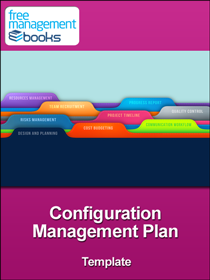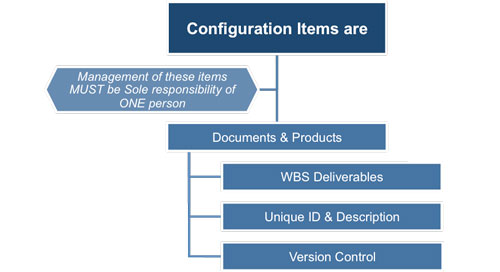
Configuration Management Plan Template
This template helps you to create a configuration management (CM) plan. This resulting document enables you to describe to the stakeholders how configuration management will be managed for their project, list the CM tools that will be used to endorse success.
In the creation of a project plan, lower level plans are developed to meet specific needs of that project, for example, the configuration management plan. Projects documentation is usually extensive and there must be a well-defined administrative process in place to keep track of all documents that are produced during the project life cycle.
Its purpose is to ensure that the correct document is circulated in a timely manner to those who need it to perform their role and complete the deliverables they are accountable for. Projects are a complex ‘living’ entity that evolve as they mature adapting to circumstance in a way that ensures their ‘survival’ i.e. attainment of the project objective. This evolutionary process applies to both project documentation and the project deliverables.
Configuration items (CI’s) are all the documents and products that are required to administer and control the configuration management method used in a project. Day-to-day responsibility of configuration management is most effective when only a single person has responsibility for it.
Configuration items increase from its highest level of the end-product to encompass each deliverable as defined in the work breakdown structure (WBS) that lists each manageable element. A record or register of configuration items should be created giving a unique description and ID (often a three or four digit number) to each one. This enables each item to be monitored and tracked throughout the length of the project.
Projects often have complex relationships that intertwine and this inter-relational should be reflected in document management. A configuration management plan defines the procedures that enable the right version of a document to be distributed appropriately to all pertinent product components and project information. It also ensures the accuracy of all documentation, which is essential in all projects what ever their size.
At its inception a configuration item (CI) will be assigned a unique ID that denotes it as the first version. With each modification or correction the version number will increase. Each configuration item evolves as a result of testing, identification and correction of errors or due to the incorporation of amendments resulting from requested changes. Only when all these alterations have been agreed will the configuration item be considered at its first baseline, subsequent baselines are created when major changes occur that transform its structure or content to suit the work required.
Another significant area for the configuration management plan is the issue of a set of items that need to communicate at the same time for a specific purpose. This is activity is referred to as ‘a release’ and must be authorized by the project manager. Often within organizations several projects are being conducted simultaneously and they may have common interests and it is essential that a common configuration management method is used for all such projects to ensure consistency and efficiency.

Therefore the purpose of the configuration management plan as applicable too most project are shown in the above diagram. Your plan will need to reflect the culture of the organization and the particular nature of the project itself. This plan also needs to provide an outline of:
• Differences in expected standards and procedures that are required for this project.
• Provide an explanation of the activities aims outlined in the plan.
• List of interrelated aspects or dependencies that this plan has with other projects.
• Describe the security measures being taken for all CI master copies
The configuration administrator, or an assigned individual, is the one who decide whether a project document that needs to distribute amongst the team represents a configuration item (CI) or not. Those that are assigned a centrally held CI version and number must adhere to the configuration management system when being distributed. This central record contains all the necessary data for a CI so that it can be identified and tracked throughout the life of the project.
As configuration items are identified, each should have a configuration item description record created for it – which should then be forwarded to the configuration administrator for filing. The configuration item description record should contain all of the information needed to identify and track the item through its development life cycle. The administrator produces all the necessary reports that relate to the status of the configuration items.
Configuration management is a method for administering an evolving, and often interrelated, set of products and project documentation. The application of effective procedures should ensure the accurate and up-to-date documentation and distribution of all relevant product components and project information. Configuration Management should be applied to projects of any significant size, and should be the day-to-day responsibility of a single individual.
